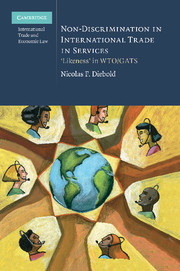Book contents
- Frontmatter
- Contents
- Foreword
- Acknowledgements
- Abbreviations
- List of Cases
- List of Legal Texts
- List of Documents
- Introduction
- PART I Foundations
- PART II Framing the conceptual breadth of ‘likeness’ in GATS
- 5 ‘Likeness’ in national treatment
- 6 ‘Likeness’ in MFN treatment
- 7 Comparative analysis of ‘likeness’
- 8 Concluding summary: economic standard
- PART III GATS specific ‘likeness’ issues
- PART IV Methodology for the ‘likeness’ analysis in GATS
- Bibliography
- Index
7 - Comparative analysis of ‘likeness’
Published online by Cambridge University Press: 10 January 2011
- Frontmatter
- Contents
- Foreword
- Acknowledgements
- Abbreviations
- List of Cases
- List of Legal Texts
- List of Documents
- Introduction
- PART I Foundations
- PART II Framing the conceptual breadth of ‘likeness’ in GATS
- 5 ‘Likeness’ in national treatment
- 6 ‘Likeness’ in MFN treatment
- 7 Comparative analysis of ‘likeness’
- 8 Concluding summary: economic standard
- PART III GATS specific ‘likeness’ issues
- PART IV Methodology for the ‘likeness’ analysis in GATS
- Bibliography
- Index
Summary
Following the interpretation of ‘likeness’ in GATS in the light of GATT non-discrimination rules, chapter 7 extends this comparative analysis to other disciplines within and outside the WTO framework. Section I looks at ‘likeness’ the way it applies in non-discrimination obligations in the TBT and SPS Agreements, whereas section II turns to non-discrimination obligations of international economic law outside the WTO agreements, focusing in particular on NAFTA and BIT provisions. Section III returns to the WTO framework, but analyses the element of ‘likeness’ as it applies under trade remedies law outside the non-discrimination principle.
‘Likeness’ in the TBT and SPS Agreements
Both the TBT and the SPS Agreement provide for more specific obligations in their respective field of regulation than the basic obligations set forth in GATT. The TBT Agreement prevents unnecessary trade obstacles being created by technical regulations, such as standards and certification procedures. The SPS Agreement seeks to prevent the creation of trade obstacles through the application of sanitary and phytosanitary measures, such as food safety and health regulations. Both agreements contain basic non-discrimination obligations similar to the ones in GATT and GATS. Pursuant to Article 2.1 TBT Agreement:
‘Members shall ensure that in respect of technical regulations, products imported from the territory of any Member shall be accorded treatment no less favourable than that accorded to like products of national origin and to like products originating in any other country.’
- Type
- Chapter
- Information
- Non-Discrimination in International Trade in Services‘Likeness' in WTO/GATS, pp. 140 - 170Publisher: Cambridge University PressPrint publication year: 2010



